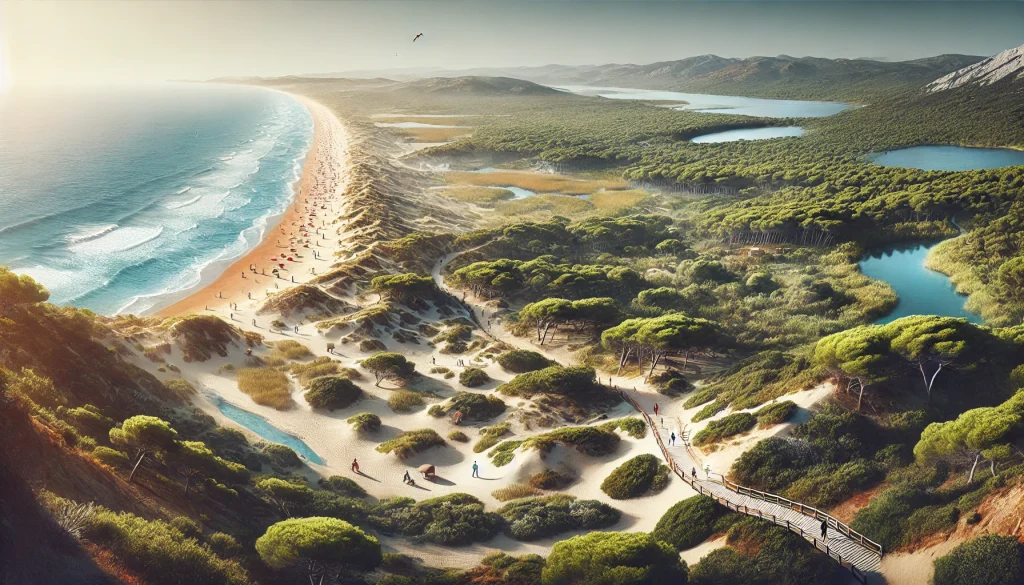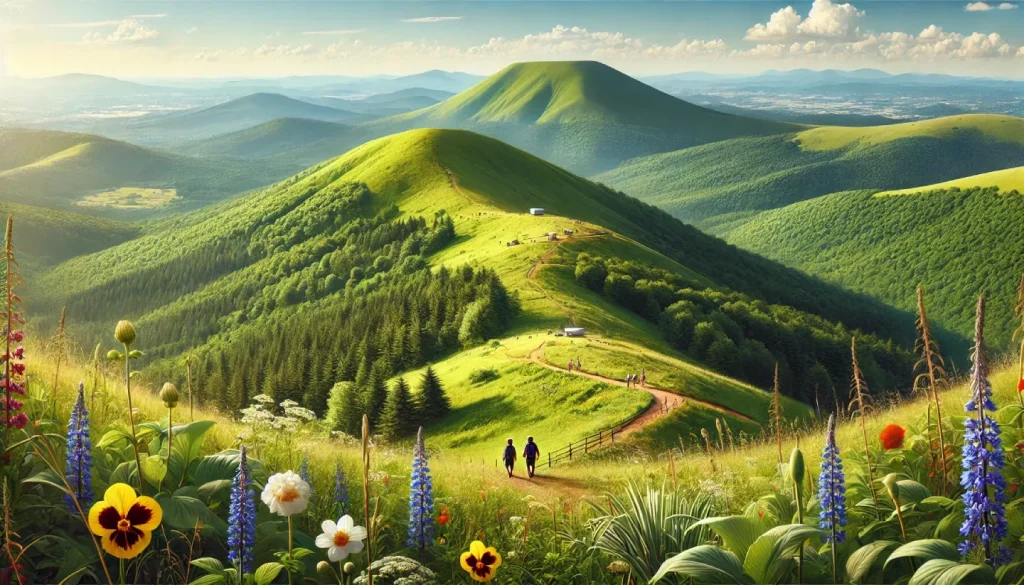
Tuscany, a region in central Italy, is famed for its rich history, art, and stunning landscapes. Beyond its cultural treasures, Tuscany boasts an abundance of natural beauty, making it an ideal destination for nature excursions. Tuscan parks and nature reserves offer visitors the chance to explore scenic trails, observe diverse wildlife, and immerse themselves in picturesque landscapes. In this article, we delve into the best nature excursions in Tuscany, highlighting the unique features and attractions of its parks and nature reserves.
Table of Contents
- Introduction to Tuscan Parks and Nature Reserves
- Why Visit Tuscan Nature Parks?
- Top Parks and Nature Reserves in Tuscany
- Parco Naturale della Maremma
- Casentinesi Forest National Park
- Monte Amiata
- Pianosa Island
- Parco di Migliarino, San Rossore, Massaciuccoli
- Orbetello Lagoon and WWF Oasis
- The Benefits of Nature Excursions
- Hiking in Tuscany
- Cycling Adventures
- Birdwatching in Tuscan Parks
- Wildlife Observation
- Photography Tips for Nature Excursions
- Family-Friendly Nature Activities
- Sustainable Tourism in Tuscan Nature Reserves
- Planning Your Visit
- Cultural Significance of Tuscan Natural Landscapes
- Frequently Asked Questions about Tuscan Parks
- Conclusion
Introduction to Tuscan Parks and Nature Reserves
Overview of Tuscan Parks
Tuscany is home to a variety of parks and nature reserves that showcase the region’s diverse ecosystems. From coastal wetlands to dense forests, each park offers a unique glimpse into Tuscany’s natural heritage. Visitors can enjoy hiking, birdwatching, and other outdoor activities while experiencing the tranquility and beauty of these protected areas.
Importance of Nature Reserves
Nature reserves in Tuscany play a crucial role in preserving the region’s biodiversity. These protected areas provide a haven for endangered species and help maintain ecological balance. By visiting and supporting these reserves, visitors contribute to conservation efforts and ensure that these natural treasures remain intact for future generations.
Why Visit Tuscan Nature Parks?
Benefits of Nature Excursions
Nature excursions offer numerous benefits, from physical exercise to mental rejuvenation. Exploring Tuscan parks allows visitors to disconnect from the hustle and bustle of daily life and reconnect with nature. The fresh air, scenic views, and peaceful ambiance of these parks provide an ideal setting for relaxation and rejuvenation.
Connection with Nature
Spending time in nature has been shown to improve mental well-being and reduce stress. In the serene environment of Tuscan parks, visitors can experience a deep sense of calm and connection with the natural world. Whether hiking through forests or observing wildlife, these excursions foster a profound appreciation for the beauty and complexity of nature.
Top Parks and Nature Reserves in Tuscany
Parco Naturale della Maremma
Located along the coast, Parco Naturale della Maremma is renowned for its diverse landscapes, including sandy beaches, marshlands, and wooded hills. This park offers a rich array of wildlife, from deer and wild boar to numerous bird species. Visitors can explore its extensive network of trails, each providing unique perspectives of the park’s natural beauty.
Casentinesi Forest National Park
Spanning the border between Tuscany and Emilia-Romagna, Casentinesi Forest National Park is one of Italy’s largest protected areas. The park is known for its ancient forests, diverse flora and fauna, and historical sites such as the Camaldoli Monastery. Hiking trails of varying difficulty levels allow visitors to explore the park’s dense woodlands and panoramic viewpoints.
Parco Naturale della Maremma
History
Established in 1975, Parco Naturale della Maremma was created to protect the coastal ecosystems and preserve the region’s natural beauty. The park’s history is intertwined with local agricultural practices and traditional land use, which have shaped its landscapes over centuries.
Key Attractions
The park’s attractions include the pristine beaches of Marina di Alberese, the Torre della Bella Marsilia watchtower, and the ancient Abbey of San Rabano. These sites offer a blend of natural and historical beauty, making them popular stops for visitors.
Wildlife
Parco Naturale della Maremma is home to a rich variety of wildlife. Visitors may encounter species such as the Italian wolf, fallow deer, and the elusive European otter. Birdwatchers will find a haven in the park’s wetlands, where they can observe species like the purple heron and the greater flamingo.
Casentinesi Forest National Park
Historical Significance
The history of Casentinesi Forest National Park is deeply rooted in the region’s cultural and religious heritage. The park encompasses ancient monasteries and hermitages, reflecting its historical importance as a place of spiritual retreat.
Flora and Fauna
The park’s dense forests are home to a wide variety of plant and animal species. Visitors can find rare plants like the Apennine edelweiss and the Italian maple. The diverse fauna includes the golden eagle, European lynx, and numerous amphibian species.
Hiking Trails
Casentinesi Forest National Park offers a range of hiking trails, from easy walks to challenging treks. Popular trails include the Sentiero degli Eremiti, which leads to secluded hermitages, and the panoramic routes offering stunning views of the Apennine Mountains.
Monte Amiata
Geological Features
Monte Amiata, a dormant volcano, stands as a prominent feature in Tuscany’s landscape. Its geological history has created unique formations and mineral springs that attract geologists and nature enthusiasts alike.
Popular Activities
Monte Amiata is a hub for outdoor activities. Visitors can enjoy skiing and snowboarding in the winter, and hiking and mountain biking in the summer. The mountain’s trails offer breathtaking views and the opportunity to explore its volcanic terrain.
Best Times to Visit
The best times to visit Monte Amiata are spring and autumn when the weather is mild, and the landscape is vibrant with seasonal colors. Winter is ideal for snow sports enthusiasts, while summer attracts hikers and nature lovers.
Pianosa Island
Historical Background
Pianosa Island, once a penal colony, is now a protected area within the Tuscan Archipelago National Park. The island’s history is reflected in its abandoned buildings and fortifications, offering a glimpse into its past.
Marine Life
The surrounding waters of Pianosa Island are a marine protected area, teeming with diverse marine life. Snorkelers and divers can explore the vibrant coral reefs and encounter species such as sea turtles, dolphins, and a variety of fish.
Guided Tours
Guided tours of Pianosa Island provide visitors with insights into its history and natural beauty. These tours often include visits to historical sites, nature walks, and opportunities for snorkeling and diving.
Parco di Migliarino, San Rossore, Massaciuccoli
Overview
This park covers a vast area along the coast and includes diverse habitats such as dunes, forests, and wetlands. The park’s varied landscapes make it a popular destination for nature enthusiasts and birdwatchers.
Key Sites
Key sites within the park include the ancient pine forests of San Rossore, the expansive beaches of Migliarino, and the tranquil Lake Massaciuccoli. Each site offers unique opportunities for exploration and recreation.
Birdwatching Opportunities
Parco di Migliarino, San Rossore, Massaciuccoli is a birdwatcher’s paradise. The park’s wetlands and coastal areas attract numerous bird species, including the Eurasian spoonbill, marsh harrier, and various migratory birds.

Orbetello Lagoon and WWF Oasis
Ecosystem Importance
Orbetello Lagoon is a vital ecosystem supporting a rich diversity of flora and fauna. The lagoon’s brackish waters and surrounding wetlands provide critical habitats for many species, making it a key area for conservation.
Visitor Activities
Visitors to Orbetello Lagoon can enjoy activities such as guided nature walks, birdwatching, and boat tours. The lagoon’s serene environment and abundant wildlife make it a perfect spot for nature excursions.
Best Viewing Spots
The WWF Oasis within the lagoon offers some of the best viewing spots for observing wildlife. Elevated platforms and strategically placed hides allow visitors to watch birds and other animals in their natural habitats without disturbing them.
The Benefits of Nature Excursions
Physical Health Benefits
Engaging in nature excursions provides numerous physical health benefits. Activities such as hiking, cycling, and walking improve cardiovascular health, strengthen muscles, and enhance overall fitness. The fresh air and natural surroundings also promote a sense of well-being.
Mental Health Benefits
Spending time in nature has been shown to reduce stress, anxiety, and depression. The calming effect of natural landscapes helps clear the mind, improve mood, and increase mental clarity. Nature excursions offer a therapeutic escape from the pressures of modern life.
Hiking in Tuscany
Popular Hiking Routes
Tuscany offers a wide range of hiking routes catering to all levels of experience. Popular routes include the Via Francigena, a historic pilgrimage path, and the trails of the Apuan Alps, known for their dramatic scenery. Each trail offers a unique perspective on Tuscany’s diverse landscapes.
Tips for Hikers
Hikers should prepare adequately for their excursions by wearing appropriate footwear, carrying sufficient water, and using maps or GPS devices. It’s also advisable to check weather conditions and trail information before setting out.
Safety Measures
Safety is paramount when hiking. Visitors should stick to marked trails, inform someone of their plans, and carry a first-aid kit. In case of emergencies, knowing basic survival skills and having a means of communication are essential.
Cycling Adventures
Best Cycling Paths
Tuscany is renowned for its scenic cycling routes. The Strade Bianche, with its white gravel roads, and the routes through Chianti’s rolling hills are popular choices. These paths offer cyclists the chance to explore the region’s stunning countryside and charming villages.
Equipment Rentals
Cyclists can rent equipment from various providers in Tuscany. From road bikes to mountain bikes, rentals are available for all preferences. Many rental shops also offer guided tours and support services.
Group Tours
Joining a group cycling tour is a great way to explore Tuscany while meeting fellow enthusiasts. These tours often include support vehicles, experienced guides, and pre-planned routes, ensuring a safe and enjoyable experience.
Birdwatching in Tuscan Parks
Best Spots
Tuscany’s parks and nature reserves offer prime locations for birdwatching. The wetlands of Orbetello Lagoon, the forests of Casentinesi, and the coastal areas of Parco di Migliarino, San Rossore, Massaciuccoli are among the best spots to observe a wide variety of bird species.
Bird Species to Look For
Birdwatchers can expect to see species such as the European bee-eater, hoopoe, and various raptors. Seasonal migrations also bring a diversity of birds, making Tuscany a year-round birdwatching destination.
Birdwatching Tips
To maximize birdwatching experiences, visitors should bring binoculars, wear muted clothing, and remain quiet and patient. Early morning and late afternoon are typically the best times for birdwatching, as birds are most active during these periods.
Wildlife Observation
Common Wildlife
Tuscany is home to a diverse range of wildlife, including mammals such as deer, wild boar, and foxes. The region’s parks and reserves also host reptiles, amphibians, and numerous insect species, contributing to its rich biodiversity.
Tips for Observing
When observing wildlife, it’s important to keep a respectful distance to avoid disturbing the animals. Using binoculars or a camera with a zoom lens can enhance the experience. Visitors should also move slowly and quietly to increase their chances of spotting wildlife.
Ethical Wildlife Viewing
Ethical wildlife viewing involves minimizing human impact on animals and their habitats. Visitors should avoid feeding wildlife, stick to designated paths, and follow guidelines set by park authorities. Respecting nature ensures that these environments remain pristine for future generations.
Photography Tips for Nature Excursions
Best Locations
Tuscany’s parks and nature reserves provide stunning backdrops for photography. Iconic locations include the rolling hills of Val d’Orcia, the forests of Casentinesi, and the coastal vistas of Parco Naturale della Maremma. Each location offers unique opportunities for capturing the region’s natural beauty.
Photography Gear
For nature photography, a DSLR or mirrorless camera with a variety of lenses is recommended. Wide-angle lenses are ideal for landscapes, while telephoto lenses are useful for wildlife shots. A tripod can also help stabilize the camera for sharper images.
Composition Tips
Effective composition can make a significant difference in photography. Utilizing techniques such as the rule of thirds, leading lines, and framing can enhance the visual impact of photos. Paying attention to lighting and timing, especially during golden hours, can result in stunning images.
Family-Friendly Nature Activities
Kid-Friendly Trails
Many of Tuscany’s parks offer kid-friendly trails that are easy to navigate and full of interesting sights. Trails with interpretive signs, interactive exhibits, and opportunities for wildlife spotting are particularly engaging for children.
Educational Programs
Educational programs and guided tours tailored for families can enrich the nature excursion experience. These programs often include hands-on activities, nature crafts, and informative talks that make learning about nature fun and interactive.
Picnic Spots
Picnic spots within the parks provide perfect settings for family outings. Many parks have designated picnic areas equipped with tables and benches, offering a comfortable place to relax and enjoy a meal amidst nature.

Sustainable Tourism in Tuscan Nature Reserves
Eco-Friendly Practices
Visitors can support sustainable tourism by adopting eco-friendly practices such as reducing waste, using reusable items, and opting for public transportation or cycling. Staying in eco-friendly accommodations and supporting local businesses also contribute to sustainable tourism.
Leave No Trace Principles
The Leave No Trace principles guide visitors in minimizing their impact on the environment. This includes disposing of waste properly, respecting wildlife, and leaving natural objects as they are found. Practicing these principles helps preserve the natural beauty of Tuscan parks.
Supporting Local Conservation
Visitors can support local conservation efforts by participating in volunteer programs, donating to conservation organizations, and spreading awareness about the importance of protecting natural areas. Engaging in these activities ensures the long-term preservation of Tuscany’s natural heritage.
Planning Your Visit
Best Times to Visit
The best times to visit Tuscan parks and nature reserves are spring and autumn, when the weather is pleasant, and the landscapes are vibrant. These seasons also offer fewer crowds, making for a more enjoyable experience.
What to Pack
Packing essentials for a nature excursion include comfortable clothing, sturdy footwear, a hat, sunscreen, insect repellent, and a reusable water bottle. A backpack with snacks, a first-aid kit, and a camera is also recommended.
Local Accommodation
Tuscany offers a range of accommodation options, from rustic farm stays to luxurious villas. Many parks have nearby lodgings that provide easy access to nature trails and scenic spots. Booking in advance is advisable, especially during peak seasons.
Cultural Significance of Tuscan Natural Landscapes
Historical Sites
Tuscany’s natural landscapes are dotted with historical sites that reflect the region’s rich cultural heritage. Ancient ruins, medieval castles, and historical monasteries add depth to the nature excursion experience, providing a unique blend of history and nature.
Cultural Festivals
Cultural festivals celebrating local traditions and nature are common in Tuscany. These festivals often feature music, food, and traditional crafts, offering visitors an opportunity to immerse themselves in the local culture while enjoying the natural surroundings.
Integration with Local Traditions
Tuscany’s natural landscapes are deeply integrated with local traditions and lifestyles. Agricultural practices, culinary traditions, and artisanal crafts are all influenced by the region’s natural environment. Exploring these connections adds a meaningful dimension to nature excursions.
Frequently Asked Questions about Tuscan Parks
What are the best parks to visit in Tuscany? Some of the best parks to visit in Tuscany include Parco Naturale della Maremma, Casentinesi Forest National Park, and Parco di Migliarino, San Rossore, Massaciuccoli. Each park offers unique landscapes and a variety of outdoor activities.
What wildlife can I expect to see in Tuscan parks? Visitors can expect to see a variety of wildlife, including deer, wild boar, foxes, and numerous bird species. Specific parks may also host rare animals like the Italian wolf and the European otter.
Are there guided tours available in Tuscan parks? Yes, many Tuscan parks offer guided tours that provide insights into the local flora, fauna, and history. These tours are led by knowledgeable guides and often include activities such as birdwatching, hiking, and educational programs.
What is the best time of year to visit Tuscany for nature excursions? The best times to visit Tuscany for nature excursions are spring and autumn. During these seasons, the weather is mild, and the landscapes are particularly beautiful with blooming flowers in spring and colorful foliage in autumn.
Are there family-friendly activities in Tuscan parks? Yes, many Tuscan parks offer family-friendly activities such as kid-friendly trails, educational programs, and picnic areas. These activities are designed to engage children and provide a fun, educational experience in nature.
How can I practice sustainable tourism while visiting Tuscan parks? Visitors can practice sustainable tourism by following eco-friendly practices, such as reducing waste, respecting wildlife, and supporting local conservation efforts. Adhering to the Leave No Trace principles and choosing sustainable accommodation options also contribute to responsible tourism.
Conclusion
Tuscan parks and nature reserves offer a wealth of opportunities for nature excursions, from hiking and birdwatching to wildlife observation and photography. Each park presents its own unique landscapes and attractions, providing visitors with unforgettable experiences. By exploring these natural treasures, visitors can appreciate the beauty and diversity of Tuscany while supporting conservation efforts. Whether you’re seeking adventure, relaxation, or a deeper connection with nature, Tuscan parks and nature reserves are the perfect destinations.


